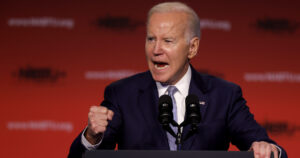When asked in 2020 to envisage the world after Covid, Michel Houellebecq proclaimed, accurately enough, that “it will be the same, just a bit worse”. As this year slams to a bloody close, it does not take a soothsayer to foresee that the same prediction will hold true for the coming year. The year 2023 saw the greatest global resurgence of armed conflict since 1945: 2024 will be worse. We are living, if not through a World War, then a world at war, the great post-globalisation jostling to divide up the spoils of what was once America’s unipolar imperium. This will be as epoch-defining a period as the late Forties were for Britain, or 1991 for Russia.
Unlike the two World Wars, the rival great powers are not challenging the superpower directly — at least, not yet. Instead, American hegemony is being challenged obliquely, as its rivals nibble at the edges of empire, targeting weaker client states in the confidence that the United States now possesses neither the logistical capacity nor the domestic political stability necessary to impose its order on the world. In the Nineties and 2000s, at the height of its unipolar moment, the United States made almost all the world its client state, writing cheques for their security it now struggles to cash: like bankruptcy, decline comes slowly at first, then all at once. The overriding theme of 2024 then, like 2023, will be that of imperial overstretch precipitating retreat from global dominance. From the Red Sea to the Donbas, the jungles of South America to the Far East, America’s security establishment finds itself struggling to contain local blazes that threaten to become a great conflagration.
Yet bad as things are, they could always be worse. We perhaps too easily forget that only six months ago, in the immediate wake of Prigozhin’s dramatic and unexpected rebellion, Russia’s security establishment was engaged in vigorous and public discussion over whether it was necessary to conduct a nuclear strike either in Ukraine, as a warning against the West, or against the West itself. So endemic has the sense of crisis, both globally and domestically, become that the most dangerous nuclear escalation since the Cold War went largely unremarked. We should be grateful that this moment passed, yet the fact it did pass is itself evidence of America’s weakening global position. The brief episode of nuclear anxiety came at a time when Putin’s Kremlin faced both an unprecedented internal threat and the risk of battlefield defeat, on the brink of Ukraine’s much-anticipated summer offensive. But the offensive, as we now know, faltered into a costly defeat for Ukraine, upturning the expected outcome of the war. For our now-lowered risk of nuclear war, Kyiv will pay a heavy price.
Like an inscrutable game of chess, the battle lines in Ukraine have barely moved this year, but expectations for the war’s outcome have been totally reversed. This time a year ago, the consensus was that the invasion was already a strategic defeat for Putin: his armies had proved unexpectedly ineffective on the battlefield, and had crumbled before Ukraine’s rapid autumn 2022 northeastern counteroffensive. Rather than breaking apart through its internal divisions, the Nato alliance had found a new sense of purpose, consolidating itself against the Russian threat and devoting vast quantities of already-existing and soon-to-be-produced materiel towards military victory. That mood of triumphalism has already passed. The promised war-winning Western increase in munitions production simply has not materialised, while Russia’s transition to a war economy, and its seizing of Western companies in response to a sanctions regime whose effects have proved the opposite to those intended, have granted Russia both renewed offensive potential and an economic boom to pay for it. The West imposed on Russia a war stimulus it should have embraced itself. It did not, and as a result this winter is a bleak one for Ukraine; but the year to come looks to be far worse.
Through 2023, Kyiv and its Western backers gambled a successful conclusion to the war on a single armoured thrust in the country’s southeast, punching through Russia’s defensive lines and threatening its hold on the Crimea and Black Sea coast, forcing a humbled Putin into peace negotiations. That gamble failed, and there is now no viable path towards the expansive definition of victory adopted by Zelenskyy at a more buoyant phase of the war. Along the northern border and behind the current lines in the East, Ukrainian forces are hurriedly digging defensive lines, hoping to blunt Russia’s resurgent offensive power in the same way Russia’s fortifications chewed up its own newly-formed and Nato-trained armoured brigades. The “mountain of steel” donated for the offensive by the West will not be repeated; the wave of enthusiastic volunteers who initially manned the lines has been replaced by increasingly unwilling conscripts, with Kyiv planning a further mobilisation of half a million men just to hold the line.
When Zelenskyy’s over-optimistic prognoses of the war’s conclusion were punctured by his military chief General Valerii Zaluzhny characterising the current state of play as a “stalemate”, it revealed growing internal political strife within the Kyiv leadership. But the hard reality is that now offensive momentum has passed to Russia, Ukraine forcing the war into a stalemate that will lead to peace negotiations looks as close to victory as will realistically be achieved. But as things stand, an increasingly confident Moscow shows no inclination towards peace talks without Ukraine making territorial and political concessions indistinguishable from surrender. That Zelenskyy’s senior advisors are floating the possibility of Putin’s sudden overthrow in Moscow as a possible path to victory shows the scale of the threat facing Kyiv. Short of a revolutionary deus ex machina in the Kremlin, the challenge for Ukraine in 2024 will be to hold its defensive lines, degrade Russia’s offensive power faster than its recruitment and industrial production can replace, and maintain the necessary political unity in Kyiv to steer the war towards the least painful conclusion possible. Of all these, perhaps the last will be the greatest challenge.
But as Kyiv struggles, the hegemon is already losing interest in Ukraine, distracted again by its decades-long enfeebling entanglement in the Middle East. Israel is both diplomatically and militarily dependent on the United States, but that relationship is not reflected in Netanyahu’s prosecution of his punitive war on Gaza. When US envoys beg Israel to scale down its war, Netanyahu immediately promises to intensify it. Even as American planners fret over the erosion of their precious munitions stockpiles by the Ukraine war, Israel is burning through US-donated supplies at an alarming rate. Until the US can increase its munitions production and replenish its arsenal, which may take years, every shell fired on Gaza or in eastern Ukraine weakens America’s deterrent power. The result will be the arms equivalent of the “hungry gap”, as its available military resources become increasingly unequal to its global commitments. This shortfall presents America’s rivals with a rare and unexpected window to challenge the superpower directly, in the knowledge that it will struggle to fight a high-intensity war of any great duration.
But if the logic of armaments production, as well as the diplomatic isolation and domestic outrage fuelled by the Gaza war, drives the United States to seek a swift resolution to the conflict, the logic of events leads towards escalation. The risk of the conflict widening to Lebanon has not abated — if anything, Israel appears to be straining at the leash to extend its full-scale war across its northern frontier, as thousands of Israeli civilians have fled their homes as a result of the tit-for-tat exchange of artillery fire with Hezbollah. Yet the blockade of Red Sea shipping by Yemen’s Houthi movement has shown that Western countries face direct costs for their increasingly qualified support of Israel, and that regional powers are increasingly confident in challenging the United States directly.
Having triumphantly survived a years-long war against Saudi Arabia, devastating to Yemen’s civilian population, in which Saudi forces deployed US jets, bombs and intelligence support to little battlefield effect, the risk of a short-lived American punitive bombing campaign must seem a manageable one to the Houthis. Knowing that America has no appetite for a wider conflict that will be seen both internationally and domestically as having been dragged into a war on Israel’s behalf, the Houthis now feel emboldened to attack US naval escorts directly. So politically toxic is Israel’s Gaza campaign that even America’s closest Nato allies prefer to keep their distance from American security efforts in the Red Sea, while as a result of poor procurement decisions, the US Navy is struggling to marshal the resources necessary to keep trade routes open, the basic function of a global empire. Balking at fighting Hezbollah or the Houthis directly, the prospect of a US attack on Iran, deemed an over-ambitious goal even at the height of US power, is unlikely in the extreme, which in turn feeds Tehran’s appetite for risk. Overstretched, wearing down its ships through over-deployment, and suddenly showing itself dependent on weaker, unenthused European allies to make up the numbers, in the Red Sea we are shown a glimpse of America’s naval performance in a future Pacific conflict: the results will be heartening to China.
Like an ailing mammoth, weakened by a succession of individual spear thrusts, the hegemon staggers bleeding across the global scene. Though stronger than any individual competitor, America is not capable of sustaining three simultaneous major conflicts against powerful regional rivals, without mobilising for a war effort unfeasible within its current political dynamics. At the height of its power, when America’s rivals were cowed and isolated, the United States assumed global security burdens that looked easily achievable at the time, while running down the industrial base necessary to sustain them. Bad choices were made, which are now difficult to undo. As a result, the United States has already shifted into a defensive mode, attempting to preserve its gains of better times against resurgent challengers, and delaying the grand-political reordering of global affairs for as long as possible. Yet unlike Russia, Iran or China, America’s democratic system incentivises short-term planning, and offers its leaders the escape route of shifting responsibility for failure to the next, rival administration. Heading towards what looks like an inevitable political defeat in 2024, the Biden administration is already drained of political authority, as tired and absent-minded as the gerontocrat at its helm.
In an earlier phase of America’s history, the looming handover of power would be expected to happen smoothly, and continuity achieved in maintaining the empire’s strategic goals. No such continuity can be expected in 2024. America’s previous two elections were marked by the most serious waves of civil disorder and political instability in decades as each party and their factions within the state bureaucracy contested each others’ legitimacy, each deploying excitable civilians radicalised by their respective court press as proxy weapons. Over the course of the coming year, America will likely be roiled by its internal political dysfunction in a way we have never yet seen, and the rest of the world will live in the shadow cast by the contested imperial throne.
Not just the fate of Ukraine but also of the Nato alliance will be determined by the battle for power in Washington. For Netanyahu, the incentive of America’s election year will be to drag the war out for another year, or widen it into a regional conflict, gambling Israel’s future security on the presumed greater indulgence of the incoming Republican administration. Similarly, for Iran, Hezbollah and the Houthis, the waning days of a cautious Biden administration desirous to avoid a Middle Eastern conflagration presents the greatest opportunity for escalation. For China, waiting in the wings to deliver the final blow, the optimum time to act will be at the moment of Washington’s greatest distraction by internal disorder: perhaps this election season will present an opportunity too rare to pass up, accelerating the timetable to seize Taiwan.
The world is living through its most dangerous moment in many decades, and the logic of events, in every theatre, leads towards further escalation over the year to come. In 2024, America’s fraught domestic interregnum will create a feedback loop with the already bloody global interregnum for the spoils of its empire. Last year was a hard year, drenched in blood and human misery through global conflict: but in retrospect, we may view it as the last golden summer of our world order, with the troubling storms still distant on the horizon. The coming year will be a historic one: we are right to dread its approach.
Disclaimer
Some of the posts we share are controversial and we do not necessarily agree with them in the whole extend. Sometimes we agree with the content or part of it but we do not agree with the narration or language. Nevertheless we find them somehow interesting, valuable and/or informative or we share them, because we strongly believe in freedom of speech, free press and journalism. We strongly encourage you to have a critical approach to all the content, do your own research and analysis to build your own opinion.
We would be glad to have your feedback.
Source: UnHerd Read the original article here: https://unherd.com/





